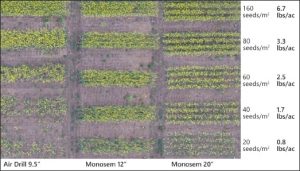Good canola establishment with narrow-row planter
For this study conducted in southern Alberta on irrigated and dryland plots, the precision planter with 12″ spacing increased seedling emergence and plant stand density compared to the conventional air drill and precision planter with 20″ spacing — as long as seeding rates were higher than 20 seeds/m2.
PROJECT TITLE, PRINCIPAL INVESTIGATOR:
“Developing Canola Agronomy with Precision Planters,”
Lewis Baarda and Ken Coles,
Farming Smarter
Funding:
Alberta Canola and Manitoba Canola Growers

Precision planters are being used to seed canola in order to improve seedling emergence, stand establishment and yield. To determine the efficiency of precision planters for canola seeding, Farming Smarter conducted field experiments at three locations across southern Alberta from 2016 to 2019. The study compared the performance of precision planters (12″ and 20″ seeding row width) and conventional air drill seeder at five different seeding rates (20, 40, 60, 80 and 160 seed/m2) for their effect on the emergence, growth and yield of canola.
Canola growth, yield and seed quality were estimated using various parameters including crop emergence, plant density, canopy closure (determined using normalized difference vegetation index and fractional green canopy cover measurements), plant vigour ratings, seed yield, kernel weight, oil concentration and dockage.
When seeding rates were higher than 20 seeds per square metre, the precision planter with 12″ spacing increased seedling emergence and plant stand density compared to the conventional air drill and precision planter with 20″ spacing. Seedling emergence was also observed to be more uniform for the precision planters compared to the air drill across both irrigated and rainfed locations.
Additionally, the green canopy covering and plant vigour improved with the precision planter (12″) compared to the air drill – especially at higher seeding rates (i.e. 80 and 160 seeds/m2). At seeding rates less than 60 seeds/m2, crop vigour and canopy covering for air drill were comparable to or higher than the precision planter (12″).
The precision planter with 20″ spacing led to poor crop emergence and canopy covering for all seeding rates compared to both the seeders. The wider 20” rows on the precision planter delay canopy closure.
Additionally, more seeds need to be placed in each row, thus leading to higher competition between the plants for resources such as water, sunlight, and nutrients. Consequently, 20″ planters led to a significant decrease in yield across all seeding rates. On average, canola yield with 20″ planter decreased by 20 to 28 per cent compared to the conventional air drill. Thus, the adoption of wide row (20″) precision planters for the seeding of canola is not recommended.
Narrow (12″) planters, on the other hand, led to two to 10 per cent increase in canola yield compared to air drill. At the irrigated plot, the increase in canola yield with precision planter (12″) was even higher. Similarly, the 12″ precision planter led to higher canola yield in years with higher annual precipitation (2016 and 2017), while the air drill led to a relatively higher or comparable yield to the precision planter (12″) in years 2018 and 2019, which had low annual precipitation.
The investigators conclude that under favourable conditions for crop growth, spatially uniform crop stands established by precise placement of seeds allow for more efficient utilization of resources by individual plants, and less inter-plant competition, thus leading to better crop growth and yield.
Phosphorus trial
This study also tested the application of liquid phosphorus (P) within seed rows at different rates. Liquid P application at 60 kg/ha showed some degree of seedling mortality in case of the precision planters (12″ and 20″), thus leading to lower plant emergence and canopy covering. However, no such observation of seedling mortality or decrease in plant emergence was made for the lower P application rates between 0 to 40 kg/ha for any of the seeders. For the narrow (12″) precision planter, crops were able to recover from the initial losses leading to no substantial difference in yield for different P application rates. However, crop recovery was less effective for the 20″ planter, thus leading to a lower yield at 60 kg/ha application rate of liquid P.





